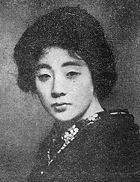
Sumako Matsui
Encyclopedia

Japan
Japan is an island nation in East Asia. Located in the Pacific Ocean, it lies to the east of the Sea of Japan, China, North Korea, South Korea and Russia, stretching from the Sea of Okhotsk in the north to the East China Sea and Taiwan in the south...
ese actress and singer
Singing
Singing is the act of producing musical sounds with the voice, and augments regular speech by the use of both tonality and rhythm. One who sings is called a singer or vocalist. Singers perform music known as songs that can be sung either with or without accompaniment by musical instruments...
. Born as Masako Kobayashi in Matsushiro, Nagano, Nagano Prefecture
Nagano Prefecture
is a prefecture of Japan located in the Chūbu region of the island of Honshū. The capital is the city of Nagano.- History :Nagano was formerly known as the province of Shinano...
as the fifth daughter and last of nine children of Tohta Kobayashi, she was adopted by the Hasegawa family in Ueda at the age of six and in 1900 graduated Ueda school. She had to return to her birth family after her adopted father died, however in the year of her return, her natural father also died. At the age of 17 she moved to Tokyo.
She married in 1903 at the arrangement of relatives but divorced within a year.
In 1908 she married Seisuke Maezawa from the same country village and in 1909 joined Shoyo Tsubouchi’s newly established theatre group only to divorce Maezawa the following October 1910.
Matsui first became famous in 1911 for her portrayal of Nora in A Doll’s House. In 1913 after establishing the Geijutsu-za theatre troupe with the shingeki
Shingeki
Shingeki was the Japanese retelling of Western realist theatre during the late 19th century through to the early 20th century. Retellings included the works of Western writers such as Henrik Ibsen, Anton Chekhov, Maxim Gorky, and Eugene O'Neill, and reflected the styles of Russian proscenium theatre...
director Hogetsu Shimamura, she became an acclaimed actress thanks to her performance in the role of Katusha in Tolstoy’s Resurrection
Resurrection (novel)
Resurrection , first published in 1899, was the last novel written by Leo Tolstoy. The book is the last of his major long fiction works published in his lifetime . Tolstoy intended the novel as an exposition of injustice of man-made laws and the hypocrisy of institutionalized church...
(translated by Shimamura). "Katyusha's song
Katyusha's song
The is a Japanese song, which was highly popular in early 20th century Japan. It was composed in the major pentatonic scale by Shinpei Nakayama. It was sung by Matsui Sumako in a dramatization of Tolstoy's Resurrection, put on in 1914 in Tokyo. The song was a huge hit, selling a large number of...
", written by Shinpei Nakayama
Shinpei Nakayama
was a Japanese songwriter, famous for his many children's songs and popular songs that have become deeply embedded in Japanese popular culture....
, which she sang in the film, became a huge hit selling over 20,000 copies at the time. This was said to be the first ryūkōka
Ryukoka
- 1914–1927: Origin :In 1914, Sumako Matsui's song "Katyusha's song", composed by Shinpei Nakayama, was used as a theme of the rendition Resurrection in Japan. The record of the song sold 20,000 copies...
song.
After Shimamura died of the Spanish flu on November 5, 1918, she committed suicide by hanging
Hanging
Hanging is the lethal suspension of a person by a ligature. The Oxford English Dictionary states that hanging in this sense is "specifically to put to death by suspension by the neck", though it formerly also referred to crucifixion and death by impalement in which the body would remain...
on January 5, 1919.
It was Matsui’s wish to be buried alongside Shimamura, with whom she had been having an affair. However, her wish was not to be granted and her grave lies with her family in her hometown of Matsushiro. Remains are also buried in the Tamon Temple in Shinjuku, Tokyo.
The movie The Love of Sumako the Actress was produced in 1947 based on her life.

